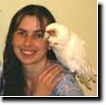Viral Infections
in Gouldians & Other Captive Birds
Kristen Reeves, Meadowlark Farms Avian Supply, Inc.
Some of these infections are classified as both viral and bacterial and may be present in both the Viral Infections section as well as the Bacterial Infections pages of this site.
ORNITHOSIS/PSITTACOSIS
This is a serious disease that affects many bird species, including Gouldian finches. It is caused by Chlamydia (a rickettsia-like organism), an intracellular disease, that without special precautions can be spread to humans through contact with infected feces and bodily fluids. It spreads easily throughout the flock, especially when cages and accessories are not kept clean or when overcrowded (poor animal husbandry practices). When birds pick at food and bedding on the bottom of the cage they sometimes pick up bits of feces, ingesting it and becoming ill with the disease. Keeping cages clean and with a minimal number of birds per cage can keep the chances of getting and spreading this disease low, but once it is in the aviary it cannot be cured. Once your bird or birds are diagnosed with ornithosis, they will be considered carriers for the remainder of their lives and should not be paired or bred. Some Veterinarians may even recommend euthanasia of any infected birds.
Mutation Gouldians are more susceptible to ornithosis due to weaker genes, but all colors may contract the disease. Symptoms can vary, often making it hard to diagnose without the aid of an Avian Veterinarian. Droppings may be watery and are usually greenish. Birds may sit fluffed, sneeze a lot or scratch at their faces. They may also have a runny nose. They may sit fluffed up and motionless with their head tucked and even a leg tucked up. Eye infections are not uncommon with this disease. Birds may sit with eyes at “half mast” as if they are sleepy. Poor breeding results combined with other symptoms may be an indicator.
If you are finding your birds won't come into breeding condition, you are finding clear eggs in the nest, or they fall out of condition soon after courting begins, have your birds tested by an Avian Veterinarian. If the disease has progressed long enough, the bird may begin having trouble standing. This usually only happens when the bird is near death.
Ornithosis/Psittacosis (Chlamydia) is a reportable disease to the CDC. It is usually treated with a tetracycline type antibiotic. Doxycycline or Chlortetracycline is usually prescribed.
POLYOMAVIRUS
“...Polyomavirus is a disease of the breeding season that infects nestlings. Adult birds cannot become infected with Polyomavirus, a disease that may permanently damage the immune system. Infected birds become incapable of repelling germs that are of no consequence for Normal Gouldians. The result is sickly individuals that are the first to fall ill when conditions are less than perfect. Infected young become carriers for life...” Dr. Rob Marshall 2003
Because I do not have experience with Avian Polyomavirus, it would be much better explained by a professional. Below this article at the bottom of the page is a file you can download to read more about Polyomavirus. It contains an exceptional article written by David N. Phalen, D.V.M., Ph.D., Texas A&M University.
The article explains in detail the history of this disease and how it is controlled. Click the link to download Avian Polyomavirus.
POX (Avian Diphtheria)
Most often seen in our aviaries and called “Canary Pox”, Avian Diphtheria is much like “chicken pox” in humans and produces the same type of blisters or lesions. Lesions are typically seen on the head, around the eyes and beak, in the nares (nostrils), and in the mouth and crop. They may be seen on the skin in other areas of the body. Like chicken pox, immunity builds up once the bird has been infected, recurrences typically are not seen.
The bird form does not affect humans. There are no known drugs to treat this viral infection, though vaccinations are available.
NEWCASTLE DISEASE (PMV-1)
Newcastle disease is highly infectious, and highly contagious. It is “reportable” to the CDC if diagnosed in your aviary.
Symptoms of Newcastle disease include difficulty breathing, nasal discharge, greenish or yellowish diarrhea, shaking and paralysis of legs and wings, loss of balance, depression, and a general “fluffed” look. The antibodies for this disease may be present in the blood, but actual confirmation is typically diagnosed through necropsy.
There is currently no treatment or cure available, but vaccinations are available for larger birds such as parrots. If your bird is diagnosed with Newcastle disease, your Veterinarian may recommend euthanasia as it is spreadable in almost every way possible - droppings, bodily fluids (from sneezing or wiping of beak on perch), and dander dust.
HERPESVIRUS (One-eyed Cold)
This infection typically affects birds under one year of age. It begins with a watery discharge from the eyes and nostrils. In some birds, the lower lid may become swollen and pus-filled. The bird may have trouble keeping its eye open and will wipe its face on the perch to clear the eye of the pus. The bird may show respiratory distress and lose its voice. A cheesy-like substance may coat the mouth and throat. The lesions look very much like Trichomoniasis infection (protozoal).
Because this disease is hard to diagnose without a full lab exam (cultures, and upon necropsy), it may be confused with other diseases including Mycoplasma infections.
There is no treatment for the virus, but anti-protozoal medications such as Dimetronidazole and Ronidizole and Trimethoprim/Sulfa may help alleviate the symptoms - especially if they are compounded by a protozoal infection.
FINAL WORD...
The information contained here is for reference purposes only. As always, if you suspect your bird is sick, take it to an Avian Veterinarian!





